Bike Test: 350cc VS 450cc VS 500cc
Whether you’re a trailrider or enduro racer – or a bit of both – choosing between the capacity options is tougher than ever before. We spent a week on trails and enduro loops to get a clearer picture of which capacity suits who better, and why. This article originally appeared in Transmoto Dirt Bike Magazine‘s 2013 June Issue (#32).
2013 Beta RR350
RRP: $11,990 | WEIGHT: 116.5kg | FROM: Italy
The only 350cc enduro bike that doesn’t roll off KTMs Austrian production line got a bunch of refinements and better suspension for 2013. And with so much torque, it does a good job of masquerading as a bigger-bore.
2012 Yamaha WR450F
RRP: $12,999 | WEIGHT: 121.3kg | FROM: Japan
It went unchanged between 2007 and 2011, Australia’s biggest-selling dirt bike was overhauled for 2012. It got a new frame, suspension, ergos and EFI, but did Yamaha do enough to get the trail-enduro mix right?
2013 KTM 500EXC
RRP: $12,995 | WEIGHT: 112.5kg | FROM: Austria
You reckon the 450EXC is KTM’s four-stroke flagship? Think again. KTM’s 350EXC-F and 500EXC both outsell its own 450EXC … and by some 50%. The 500EXC is market’s biggest-selling and most nimble big-bore.
—
Not so long ago, there was a world of difference between what was considered a ‘trailbike’ and an ‘enduro bike’. On the trail end of the spectrum, you had low-maintenance workhorses such as Suzuki’s DR-Z400 and DR650, Yamaha’s TT-R250, Kawasaki’s KLX250 and Honda’s XR range. Enduro machines, on the other hand, were regarded as expensive, uncomfortable and maintenance-intensive motocross bikes with an 18-inch rear wheel, wide-ratio gearbox and a few dickie bolt-ons to meet ADR requirements. Trailriders had little interest in these purpose-built, hardnose race weapons – most of which came from Europe.
These days, however, the line between trail and enduro bikes has been blurred. The market has demanded that trailbikes are lighter and more powerful, and that enduro models have the fuel range and versatility to hit the trails for more than 30 minutes without beating you senseless. The average dirt bike consumer now expects standout performance in a lightweight, reliable, comfortable, low-maintenance and good-looking package that doesn’t cost the earth. As a result, dirt bike manufacturers have poured their energies into producing high-performance machines that’ll appeal to a broader audience, and Australian trails are now overrun with models that sit at what was once considered the enduro end of the trail-enduro spectrum. Anyone still riding an ‘old-school trailbike’ is assumed to be a farmer or an adventure rider between adventures.
Now that there’s less emphasis on the trail versus enduro question, the market’s attention has shifted to capacity considerations. And with a growing number of engine sizes to choose from – particularly from the European manufacturers – consumers are often more concerned with a bike’s capacity than its brand these days. And here’s where it gets complicated. Advances in technology have made big-bores lighter and more user-friendly, while the smaller capacities have found substantial gains in both performance and reliability. Which means the new-generation 350, 450 and 500cc machines all offer compelling reasons for being.
Now more nimble than ever before, the big-bore thumpers don’t give much away to the smaller-capacity machines in the tight stuff. Meanwhile, the high-performance 350s are fast earning a reputation for having the optimal power-to-weight ratio; they’ve got 250-like agility in the tight going, but pull like a 400 in open terrain. Between the two sits the ‘traditional’ 450s, which remain the flagship enduro models for the Japanese manufacturers, although recent sales stats suggest they’re falling out of favour – in relative terms, anyway. KTM, Husaberg and Husqvarna, for instance, all sell a lot more of their mid-capacity and large-capacity models than they do 450s.
But why compare these three bikes? Well, both the KTM and Yamaha top the sales charts in their respective class. And while Beta’s RR350 might not match the sales of the only other 350cc enduro bikes on the market – the KTM and Husaberg – it has proven itself to be every bit as competitive. To get a well-rounded feel for the three capacities, we rode and raced them on trails and enduro loops for a week; and assessed each machine from both a trailrider’s and racer’s perspective.
Trail Considerations…
What attributes should the average trailrider focus on when choosing between the capacity options on the market? Aside from the obvious – broad, usable power and forgiving suspension – he ought to also be considering factors such as the bike’s controls, ergos comfort, fuel economy, ease of maintenance and crash resistance. So how did our three machines measure up in these terms?
The Ride
On the trail, the Yamaha offers the most stable and confidence-inspiring ride. The combination of its chassis geometry and suspension action make it the most grounded, unflappable machine of the trio. It’s so resistant to deflection and being knocked off line by loose rocks or square-edged bumps that you almost feel like you can afford to let go of the bars. It just ploughs through trail obstacles as if they’re not there, and it’s this sort of predictability that trailriders truly value. Aside from the plush ride in the first part of the stroke, the YZ-F-inspired twin-chamber fork and shock also offer excellent bottoming resistance for big G-outs and jump landings. When the terrain tightens up, however, the Yamaha loses its edge. Its steering feels heavy and indirect and it takes noticeably more effort to wrestle the bike’s front-end into turns. And in tight terrain, it’s the least agile of the three bikes to flick from side to side.
With big improvements to both its Sachs suspension and the flex characteristics of its updated frame and swingarm, Beta’s 2013 RR350 delivers a very stable ride on rock-strewn trails, which is not something all lightweight mid-capacity bikes can claim. Combined with the compact feel of the chassis and low seat, the Beta produces a very user-friendly ride in everything from tight singletrail to flowing firetrail. The fork sits up nicely in its stroke and has a progressive action at trail pace. It steers well and has a very sure-footed mid-turn feel, and it rails ruts without a second thought. But the Beta’s suspension doesn’t have the same resistance to bottoming as the other two bikes, and its shock is the first thing to lose its composure over a series of square-edged bumps.
For a big-bore machine, KTM’s 500EXC has an incredibly light feel and superbly well-balanced chassis – and that in itself makes the bike predictable and confidence-inspiring at both low and high speeds. As you’d expect, the thing is in its element on fast firetrails. But it feels every bit as agile as a 450 in tight terrain, and turns with the speed and accuracy of a much smaller-capacity bike. And unlike many big-bores, the bike’s smooth power doesn’t put undue demands on the chassis; the two work in perfect harmony.
The Power
If trailriders are looking for smooth, torquey and tractable power from engines that start easily and refuse to overheat, then all three of these bikes ought to be on their radar. No matter how many first-gear rainforest sections and gnarly hillclimbs we threw at the bikes over the course of the week, we didn’t have one issue with poor starting, bad jetting or overheating.
Like its predecessor, the 2012 WR450F has a brilliant trail engine, made even better by the Keihin fuel injection fitted last year. It delivers a seamless surge of linear power over a broad rev range and puts that power to the ground very effectively. The engine produces enough torque to make its five-speed transmission work, but it’s not as punchy as the six-speed KTM 500EXC. Which, for a majority of trailriders, is a good thing. The Yamaha is all about delivering power you can use; not power that will get you into trouble. Sadly, the cable-operated clutch on the new WR450F doesn’t complement the otherwise impeccable engine. The lever’s pivot ratio on the new model might make it slightly lighter, but the take-up is slow and this gives it an imprecise feel. Granted, this is largely because test riders are now accustomed to the hydraulic clutch that most enduro machines have moved to. But no matter how you like your modulation, the fact remains that the Yami’s clutch pull is heavy and, in tight terrain, the average guy won’t be able to use one finger on the thing for very long at all. For a bike that is so accommodating to rank and file trailriders in every other respect, the clutch is a big letdown.
As we said when we tested the Beta for the March issue, the RR350 puts out the sort of smooth and linear power that’s reminiscent of KTM’s much-lauded 400EXC. With its torquey, roll-on style power, Beta’s 350 is deceptively fast and does a great job of masquerading as a bigger-bore. It’ll happily chug up hills in third gear, and yet the thing keeps pulling hard at high revs, too. During our third-gear roll-on drag races, it was only ever a couple of bike-lengths behind the Yamaha. Although, it probably benefitted from the aftermarket FMF muffler our test bike arrived with.
KTM’s 500EXC has so much mumbo on tap (it’s good for 175km/h on the road!), but its SOHC donk remains surprisingly easy to use. It’s responsive enough to loft the front-end over trail obstacles without resorting to the clutch, but smooth enough to dial on progressively where there’s not much traction, and the thing eats hillclimbs for breakfast. That said, the Kato puts out a lot of power from low in the rev range. So unless trailriders learn to be judicious with throttle application, the KTM can be too punchy for less experienced riders. Complementing this incredibly versatile engine is the light pull and direct feel of the DDS-spec hydraulic clutch. Even if you only ride once every few months, you’ll still be able to use one finger on the thing all day.
Ergos & Controls
With a wider-than-average seat, the Yamaha is comfortable to sit on for long trailrides, but the way the seat ramps up at the junction with the tank makes it more difficult to get forward in the saddle when you really need to load the front-end. The low-bend bars create a commanding feel in the cockpit for the average trailrider who spends most of the time on his arse, but when standing, you need to stoop over on the WR-F, which isn’t comfortable on the lower back after a while. And although the low bars will suit shorter riders, the WR450F’s tall seat and added girth don’t. Blokes with short legs will find it harder to get their feet on the ground to steady the ship on snotty hillclimbs. The other thing you need to be mindful of is the Yamaha’s ignition. If you forget to turn it off when you stop the bike, it doesn’t time-out, meaning it’s easy to drain the battery. The WR-F’s kill-switch can be a bit temperamental, too.
With its lower, flatter seat and trials-inspired compact dimensions, the Beta has the least intimidating cockpit and will best suit inexperienced riders. But the seat/bar/peg triangle remains pretty conventional and won’t cramp the average 180cm bloke in the saddle, and the tall handlebar bend gives the RR350 a great standing position. The hydraulic clutch is light, but the throttle pull is noticeably heavier than the other two bikes, and can actually fatigue your right arm. And, like the Yamaha, which also runs a Nissin front brake, there’s no OTF adjuster on the front brake lever.
The KTM has a similar seat height to the Yamaha, but it’s easier to touch the ground because it’s a little narrower through the girth and runs a softer seat foam. In fact, the foam is too soft and can cause monkey-butt in no time flat. Otherwise, rider ‘interface’ with the KTM is as good as it gets. All controls are light and precise and there’s an OTF adjuster on both brake and clutch levers. Plus the rear brake gets separate adjustment for freeplay and lever position – something the Yamaha doesn’t come with. Trailriders will also appreciate the KTM’s practical clear fuel tank and standard thermo fan, and with its 9.5-litre fuel capacity (the other two bikes only carry 8 litres), the 500EXC has more fuel range. The KTM has several more useful functions on its digital instrumentation, too.
Crash Resistance
Is crash resistance really something people should consider before buying a bike? It ought to be; because when was the last time you went for a ride with some mates and didn’t see someone crash? If you were kind enough to take your mates up a steep and snotty hill, you will have seen a cartwheel or three, too. Aside from the fact that bikes start to look pretty tatty once they’ve been on their ear a few times, repairing damage can also cost you a fortune in spares – such as radiators, levers and plastics. So how vulnerable are these bikes when it all turns to poo?
Well, the Yamaha is the only bike with wrap-around handguards, and they do a bloody good job of protecting levers, bars, grips, throttle tube, switchblocks and your mitts – one of which invariably gets damaged or busted in even the slowest of crashes. But the WR-F is also the only bike without added radiator bracing, and its left-hand radiator hangs much lower than the right. Without any radiator shroud plastic to cushion the blow, it appears vulnerable to crash damage. Plus Yamaha has persisted with the hard-mounted headlight, rather than a more forgiving rubber-mounted design all the bikes from Europe now use. As history proves, a bolted-on headlight cowl increases the risk of crash damage to the headlight. And while the Yamaha’s black rims look sweet, they do scratch up quickly. After just a week’s riding, we handed the WR-F back with rims that looked like they’d just been though an ISDE. Not flat-spotted, just scuffed.
With its Italian flare, the Beta is a good-looking machine, but it’s the first machine to show signs of wear. After just a few days’ riding, the predominantly off-white decals started to lift, while the plastics
soon wore skidmark-like stains. We also buggered the instrument’s LED screen after a low-speed, low-side crash.
The handguards on the new-generation KTMs aren’t the full-wrap variety, but they’re super-strong. And both the quality plastics and the ingenious inlaid graphics barely show signs of wear after months of use. On the downside, the plastic bashplate (which is only secured by one Dzus-clip) still has a habit of coming off if you case a jump or rock ledge, but a couple of zip-ties soon fixes that.
Race Considerations…
If we take our trailrider hats off for a moment, and assess the three bikes from a racer’s perspective, what factors come into play? Well, obviously weight is the enemy of direction changes. But aside from that, more experienced riders also tend to consider the versatility of a bike’s power and whether its suspension is sophisticated enough to handle big hits. Plus they’ll look at adjustability and access issues. So how did the three bikes stack up after a couple of days around a bumpy enduro test loop?
Even with its YZ250F-inspired frame, the new WR450F remains more suited to the mainstream trail-oriented rider than the race enthusiast. Unlike the other two bikes, it’s just not possible to bolt a muffler onto the overweight Yamaha and race the thing competitively. The WR450F likes you to set up earlier for corners and draw premeditated lines, and doesn’t like being tipped into turns at the last minute or changing lines mid-corner. Yes, the Yamaha is the reigning E2-class champ at the A4DE, but racing is not the WR450F’s natural game. As it’s between 5 and 10kg heavier than its rivals in the same trim, the WR450F requires a more extensive weigh-loss program before it’s race-ready. And losing weight can be an expensive process.
We haven’t made too many positive comments about Sachs suspension in the past few years, but it’s got to be said that the Beta’s suspenders – the 48mm fork, in particular – on the 2013 RR350 are much better. In the hands of a Clubman or Expert-level racer, the Beta could be raced out of the box. But when a faster rider starts to get aggressive on it, the Beta loses its composure quicker than the other two machines – especially the shock absorber, which starts to feel harsh in the mid-stroke over a series of square-edged bumps.
At just 112.5kg (fluids, but no fuel), KTM’s 500EXC is lighter than most 300, 350 and 450cc enduro bikes on the market, and that pays big dividends when it comes to agility. Never has a big-bore machine been so good in tight terrain. Combine that with the easy-to-use power that’s responsive without being abrupt, and the 500EXC is as race-ready as any big-bore machine has ever been. But don’t think that any old trail hack can race this thoroughbred.
Bang For Buck
With the manufacturers currently bending over backwards to offer discounts, rebates and/or ridiculous value packs as incentives to buy their bikes, it’s definitely a buyer’s market. So, while the Beta’s RRP might appear a grand cheaper on paper, the reality is likely to be different on most dealer floors. But assuming for a moment that the three bikes’ listed RRPs apply, which machine offers the best value for the trail and the racetrack?
If you’re a trailrider who wants a super-reliable, go-anywhere machine with a versatile engine, forgiving chassis and suspension package and strong resale value, then go and find a Yamaha dealer who’ll cut you the best deal. Beside its clutch, the WR450F is impossible to fault for the average trailrider. If you want a bike you can trailride and race, then the lighter and more agile KTM and Beta begin to offer better value for money. Shorter and less experienced guys will gravitate toward the confidence-inspiring Beta. Bigger or more experienced racers, however, will find that the KTM’s WP suspension keeps working at speeds beyond which the Beta’s Sachs components find their limits.
When you factor in other things such as the KTM’s superior component spec, protective parts, adjustability, instrumentation and graphics durability, then the 500EXC really starts to represent hard-to-beat bang for your buck. That said, this bike has more than enough raw grunt to get the average bloke into trouble. So, unless you’re fit or strong – and preferably both (like KTM’s Toby Price, who won the 2012 AORC on a 500EXC) – you’ll be better served with a smaller machine. Either that, or just take the 500EXC trailriding instead.
Rider Feedback
PRO: Scott Keegan | 22, 79kg, 183cm
“If I pretend for a moment that I’m one of my punter mates who does a lot of low-key, sit-down trailriding, I’d be tossing up between the Yamaha and the KTM because those bikes have both got incredibly versatile and forgiving engines and suspension packages and they work really well on the trail. But when I consider things like the clear tank, fuel range, clutch and tip-weight, I think the KTM comes out ahead. As a race bike, the KTM is hands-down the best bike of the three for me. Most guys could literally race the thing as is. For me, some minimal suspension work and maybe a muffler, and it’s good to go. The Yamaha is just too heavy to race without stripping heaps of weight off it and when I start to push the Yamaha, its front-end starts to push. The Beta is good little all-rounder, and I think it’d make a great race bike for a Clubman to Expert-level guy. For me, though, it doesn’t have enough punch and response in the engine, and the shock falls well short of the other two bikes on bigger hits.”
VET/PRO: Damian Smith | 38, 68kg, 178cm
“As a trailbike, the KTM is a standout. It’s got awesome power, excellent suspension, top-shelf componentry and, thanks to all the technology that’s gone into the KTMs in recent years, it’s lost that heavy big-bore feel. It’s so light and flickable for a 500cc bike. Plus it’s got great brakes and clutch, a clear fuel tank and … well, the thing is, it’s almost impossible to fault. The Yamaha is a really comfortable bike to ride if you’re a mellow trailrider. I love how smooth and tractable the engine is and the chassis and suspension work together to make it handle predictably. Plus it’s got great bottoming resistance. But that clutch is terrible and the bike is noticeably heavy to steer and wrestle into turns. That said, I’ve heard of crazy cheap deals on the WR450Fs. You could spend any saving on fitting a hydraulic clutch. As a race bike, I’d lean toward the Beta because its capacity suits my riding style and weight better. Its Sachs suspension, however, isn’t as race-oriented as both the Yami’s and the KTM’s, so it would need a fair bit of work for me to race it.”
CLUBMAN: Kevin Allen | 34, 75kg, 174cm
“The best trailbike? That depends on how much you ride. If I were an inexperienced rider who didn’t get out much, I’d take the Beta. It’s a fantastic all-rounder with smooth power, a stable chassis and comfortable ergos. As good as the Kato is – especially its technology, suspension and nimbleness for a big bike – I reckon it’s too much bike for the average guy because the thing packs a punch if you’re not careful. I found the Yamaha’s power and suspension is really confidence-inspiring, but the heavy clutch will be a turn-off if you ride more than pure firetrail. Plus the whole bike is heavier and the tall seat height made snotty hillclimbs difficult with my shorter legs. The Yamaha just doesn’t feel like a race bike. I think you’d need to be really fit to race the KTM hard and hang onto it for too long, so the Beta RR350 would be my pick as a race bike. It needs some suspension work, but that’s about it. I really like the RR350’s ergos and the confidence it gave in technical terrain. It looks good, too.”
VET/CLUBMAN: Andy Wigan | 46, 90kg, 182cm
“Let me offer up some analogies here. The Yamaha is like a good old mate. He’s a little overweight and not very fashion-conscious, but you love him for his rock-solid temperament. His big-boned build makes him hard to knock off his feet, but he’s clumsy in confined spaces. And he needs more than a drink or two to get him into party mode. The KTM is like your Olympic athlete mate. He’s got wide shoulders and a chiselled jawline, and his loose clothing masks the fact he’s built like a brick shithouse. For a big bloke, he’s incredibly fast and agile on his feet and hasn’t an ounce of fat. There’s an air of sophistication in what he wears, but it’s practical rather than pretentious. The Beta is like your pocket-rocket mate. With his nuggety frame, low centre-of-gravity and Mediterranean looks, people expect a feisty temperament, but he’s surprisingly level-headed and fits into any social scene you throw at him. But if I could only have one mate, who would I choose? The athlete, because that bastard is always a step ahead of me.”
—
Want to view this article in magazine form? Pick up a print or digital edition of Transmoto Dirt Bike Magazine‘s 2013 June Issue (#32).
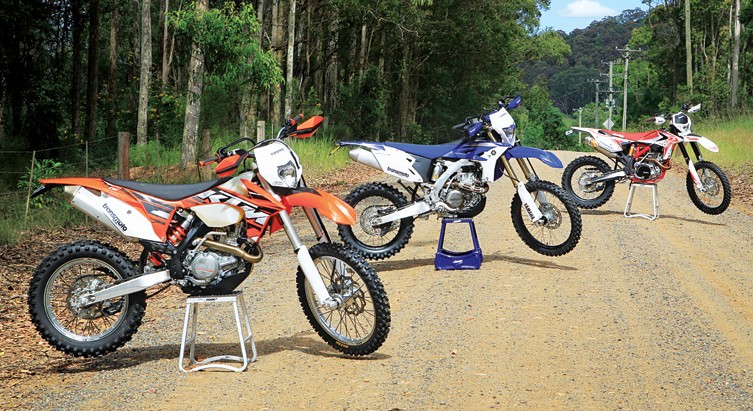
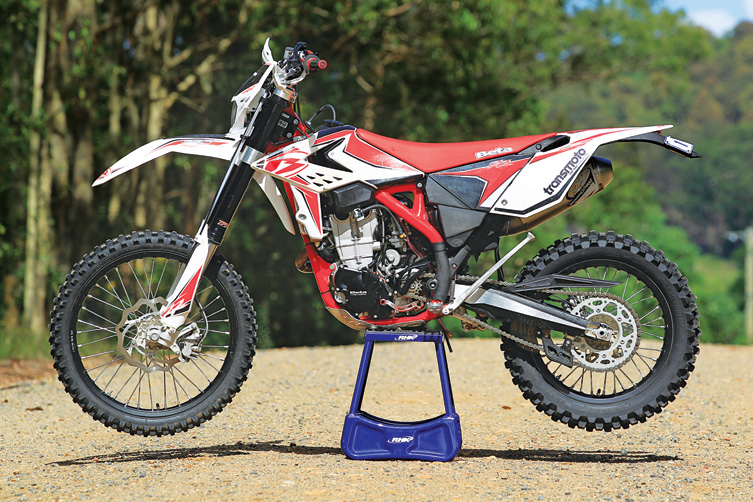
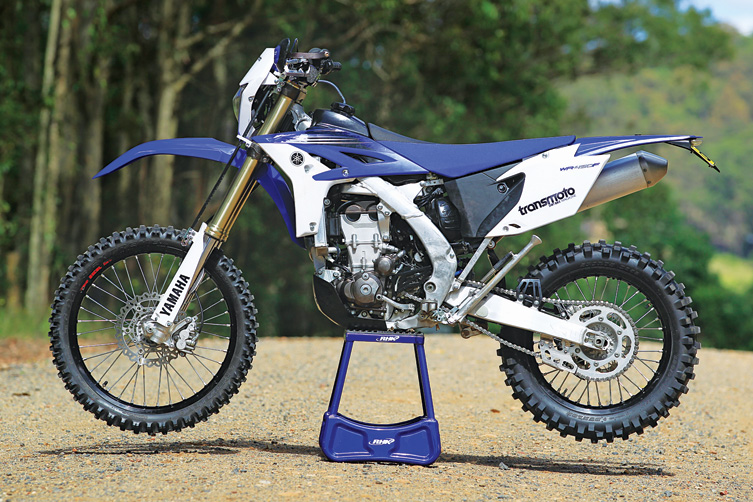

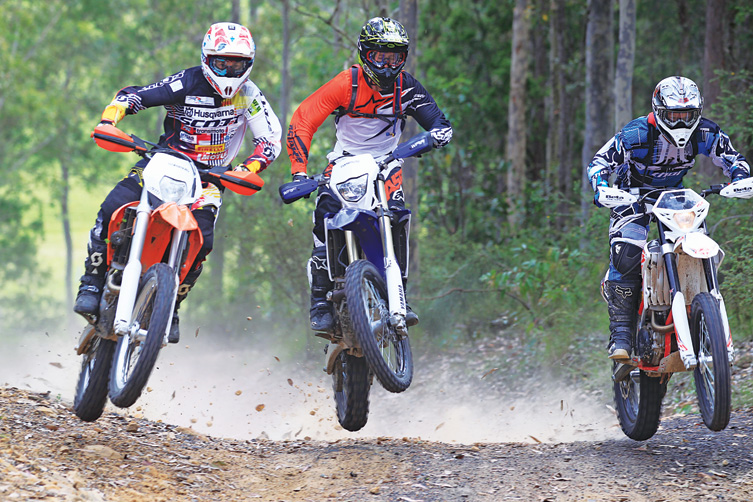
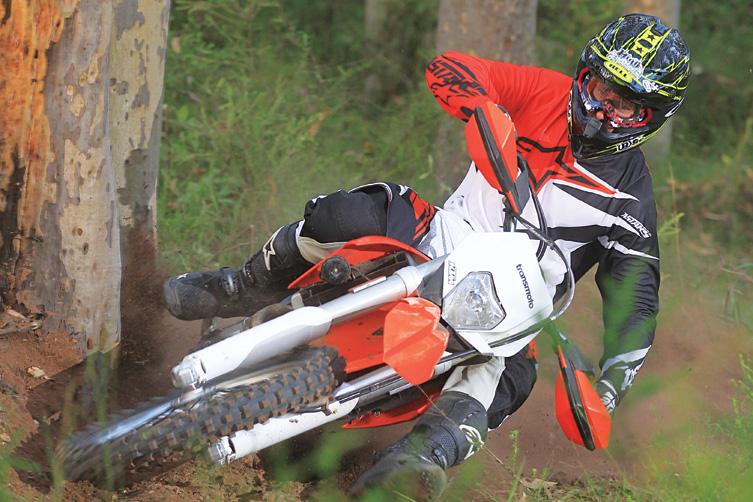
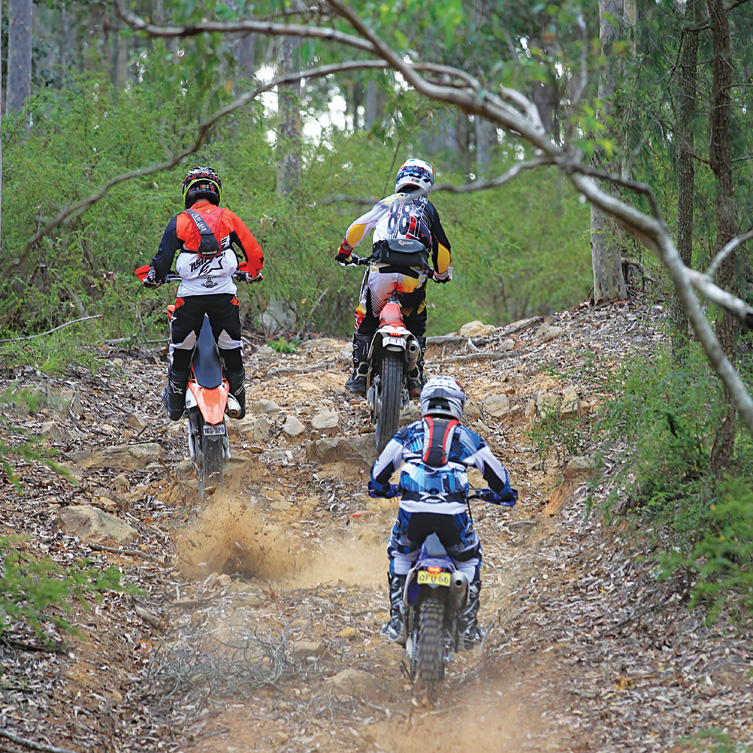
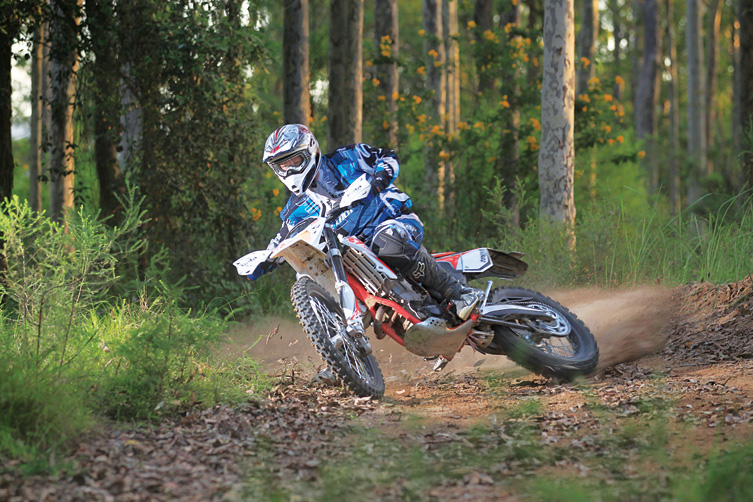
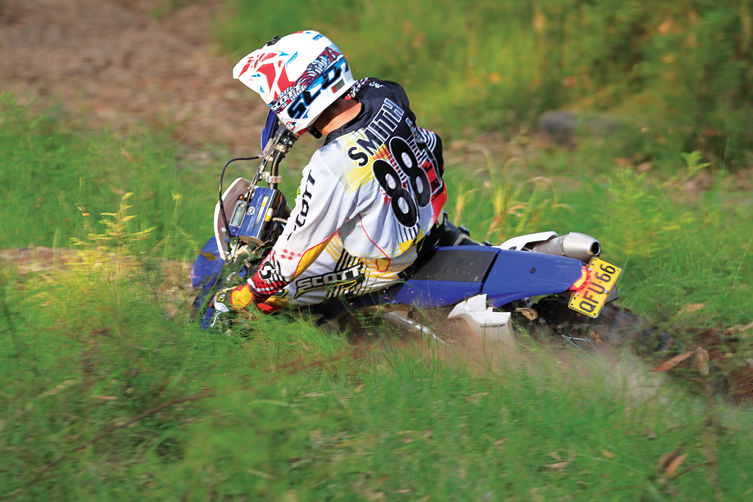

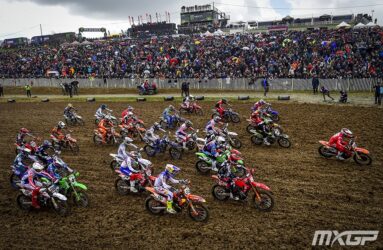


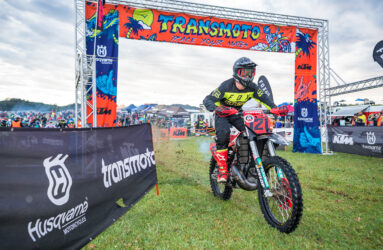


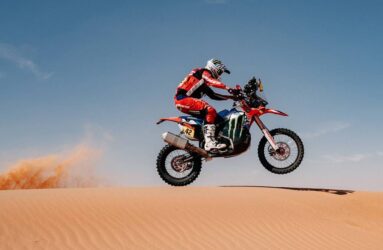
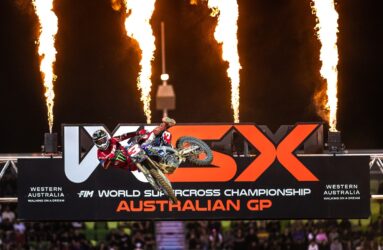
Be the first to comment...